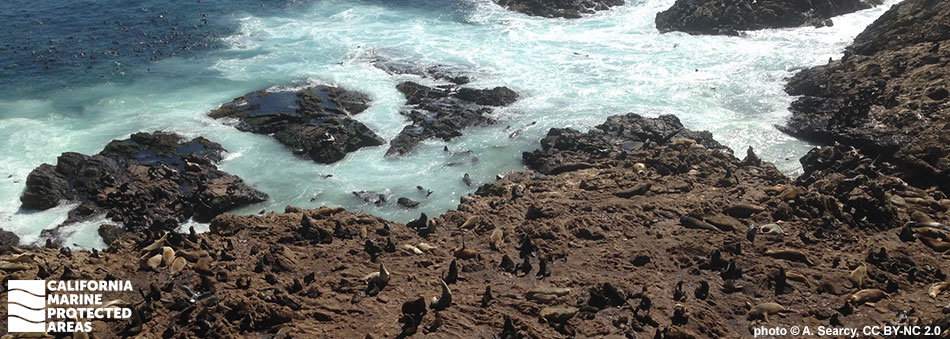
Overview
The Farallon Islands form a rugged and biologically diverse archipelago 30 miles west of the Golden Gate Bridge in the Pacific Ocean. Aptly named the Farallones, the Spanish word meaning steep rocks or cliffs, the remote islands are exposed to the wind and waves of the open ocean and, aside from large numbers of seabirds and marine mammals, are quite barren on land. There is one marine protected area (MPA) in the waters around the North Farallon Islands, the North Farallon Islands State Marine Reserve (SMR), and one special closure, the North Farallon Islands Special Closure.
Located mostly to the northeast of, but including the North Farallon Island, the SMR encompasses roughly 18 square miles of shallow, rocky seafloor near the islands, and a mix of sandy and rocky seafloor in deeper ocean waters. The islands and a cluster of smaller sea stacks within the SMR are surrounded by waters teeming with halibut, lingcod and many species of rockfish. Dropping to depths of about 275 feet, most of the SMR's seafloor is a mixture of sandy and rocky habitat.
The North Farallon Islands Special Closure extends 1,000 feet seaward from North Farallon Island and 300 feet from the other three rocky islands, including the Island of St. James, in wide bands that surround each of the respective islands. The special closure is enforced year-round and restricts boating activity, protecting important Steller sea lion haul-out sites. Minimizing human activity also protects roughly 72,000 seabirds, including the common murre, western gull, Cassin’s auklet, and pigeon guillemot, that nest on the sheer cliffs.
These protected areas have long been recognized as biodiversity hotspots, with nutrient-rich waters that support breeding seabirds and schools of forage fish. Larger marine species including humpback whales and white sharks also come here to feed.
Regulations
North Farallon Islands SMR
It is unlawful to injure, damage, take, or possess any living, geological, or cultural marine resource.
California Code of Regulations Title 14, Section 632(b)(51)(opens in new tab)
North Farallon Islands Special Closure
Boating, access, and other specific activities are restricted. No person except employees of the California Department of Fish and Wildlife, United States Fish and Wildlife Service, National Oceanic and Atmospheric Administration, or United States Coast Guard during performance of their official duties, or unless permission is granted by the California Department of Fish and Wildlife, shall enter the area.
Additional restrictions related to boating speed limits, anchoring, commercial diving operation exhaust procedures, and transit exist. See California Code of Regulations Title 14, Section 632(b)(52) for details.
California Code of Regulations Title 14, Section 632(b)(52)(opens in new tab)
Quick Facts
North Farallon Islands SMR
MPA size: 18.07 square miles
Shoreline span: 8.3 miles
Depth range: 0 to 275 feet
Habitat composition*:
- Rock: 1.03 square miles
- Sand/mud: 16.06 square miles
North Farallon Islands Special Closure
Special Closure size: 0.21 square miles
Depth: 0 to 150 feet
Habitat composition*:
- Rock: 0.24 square miles
- Sand/mud: 0.07 square miles
*Habitat calculations are based on three-dimensional area and may exceed the total MPA area listed above.